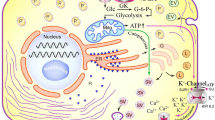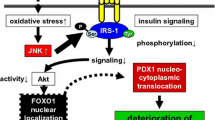Abstract
The pancreatic islet beta cells are very sensitive to oxidative stress, probably due to the extremely low level of anti-oxidant enzymes, particularly catalase. In contrast to beta cells, pancreatic alpha cells are significantly more resistant to diabetogenic toxins. However, whether alpha cells express a different level of catalase is not known. The aim of this study was to evaluate catalase expression in alpha cells of diabetic and non-diabetic mice. Diabetes was induced by a single injection of streptozotocin. After 3 weeks of persistent hyperglycemia, pancreatic tissues were collected. Catalase localization in alpha cells was identified by a dual-immunofluorescence staining with anti-glucagon and anti-catalase antibodies. In intact mice, intensive catalase and glucagon immunostaining was found in the peripheral area of islets. Merged images of glucagon and catalase show their localization in the same cell type, namely, alpha cells. Confocal microscopy indicated that the glucagon and catalase staining was distributed throughout the cytoplasm. Similar co-expression of catalase and glucagon was found in the alpha cells of diabetic animals. The results of this study show the intensive catalase expression in alpha cells of diabetic and non-diabetic mice. This knowledge may be useful to better understand the defense mechanisms of pancreatic alpha cells against oxidative stress.


Similar content being viewed by others
References
Bloch KO, Vorobeychik M, Yavrians K, Vardi P (2003) Selection of insulin-producing rat insulinoma (RINm) cells with improved resistance to oxidative stress. Biochem Pharmacol 65:1797–1805
Cabrera O, Berman DM, Kenyon NS, Ricordi C, Berggren PO, Caicedo A (2006) The unique cytoarchitecture of human pancreatic islets has implications for islet cell function. Proc Natl Acad Sci USA 103:2334–2339
Chen H, Li X, Epstein PN (2005) MnSOD and catalase transgenes demonstrate that protection of islets from oxidative stress does not alter cytokine toxicity. Diabetes 54:1437–1446
Giovagnoli S, Luca G, Casaburi I, Blasi P, Macchiarulo G, Ricci M, Calvitti M, Basta G, Calafiore R, Rossi C (2005) Long-term delivery of superoxide dismutase and catalase entrapped in poly(lactide-co-glycolide) microspheres: in vitro effects on isolated neonatal porcine pancreatic cell clusters. J Control Release 107:65–77
Grankvist K, Marklund SL, Taljedal IB (1981) CuZn-superoxide dismutase, Mn-superoxide dismutase, catalase and glutathione peroxidase in pancreatic islets and other tissues in the mouse. Biochem J 199:393–398
Lenzen S, Drinkgern J, Tiedge M (1996) Low antioxidant enzyme gene expression in pancreatic islets compared with various other mouse tissues. Free Radic Biol Med 20:463–466
Li Z, Karlsson FA, Sandler S (2000) Islet loss and alpha cell expansion in type 1 diabetes induced by multiple low-dose streptozotocin administration in mice. J Endocrinol 165:93–99
Lortz S, Tiedge M, Nachtwey T, Karlsen AE, Nerup J, Lenzen S (2000) Protection of insulin-producing RINm5F cells against cytokine-mediated toxicity through overexpression of antioxidant enzymes. Diabetes 49:1123–1130
Nielsen K, Karlsen AE, Deckert M, Madsen OD, Serup P, Mandrup-Poulsen T, Nerup J (1999) Beta-cell maturation leads to in vitro sensitivity to cytotoxins. Diabetes 48:2324–2332
Reddy S, Pathipati P, Bai Y, Robinson E, Ross JM (2005) Histopathological changes in insulin, glucagon and somatostatin cells in the islets of NOD mice during cyclophosphamide-accelerated diabetes: a combined immunohistochemical and histochemical study. J Mol Histol 36:289–300
Schnedl WJ, Ferber S, Johnson JH, Newgard CB (1994) STZ transport and cytotoxicity. Specific enhancement in GLUT2-expressing cells. Diabetes 43: 1326–1333
Takasu N, Komiya I, Asawa T, Nagasawa Y, Yamada T (1991) Streptozocin- and alloxan-induced H2O2 generation and DNA fragmentation in pancreatic islets. H2O2 as mediator for DNA fragmentation. Diabetes 40:1141–1145
Tal M, Liang Y, Najafi H, Lodish HF, Matschinsky FM (1992) Expression and function of GLUT-1 and GLUT-2 glucose transporter isoforms in cells of cultured rat pancreatic islets. J Biol Chem 267:17241–17247
Tiedge M, Lortz S, Drinkgern J, Lenzen S (1997) Relation between antioxidant enzyme gene expression and antioxidative defense status of insulin-producing cells. Diabetes 46: 1733–1742
Tiedge M, Lortz S, Munday R, Lenzen S (1999) Protection against the co-operative toxicity of nitric oxide and oxygen free radicals by overexpression of antioxidant enzymes in bioengineered insulin-producing RINm5F cells. Diabetologia 42:849–855
Xu B, Moritz JT, Epstein PN (1999) Overexpression of catalase provides partial protection to transgenic mouse beta cells. Free Radic Biol Med 27:830–837
Acknowledgments
This study was supported by a grant from the Research Foundation of Sackler Faculty of Medicine, Tel Aviv University. We thank Pepy Roizman for excellent assistance in the immunohistochemical study, and Sara Dominitz for editing the manuscript.
Author information
Authors and Affiliations
Corresponding author
Rights and permissions
About this article
Cite this article
Bloch, K., Shichman, E., Vorobeychik, M. et al. Catalase expression in pancreatic alpha cells of diabetic and non-diabetic mice. Histochem Cell Biol 127, 227–232 (2007). https://doi.org/10.1007/s00418-006-0248-4
Accepted:
Published:
Issue Date:
DOI: https://doi.org/10.1007/s00418-006-0248-4




